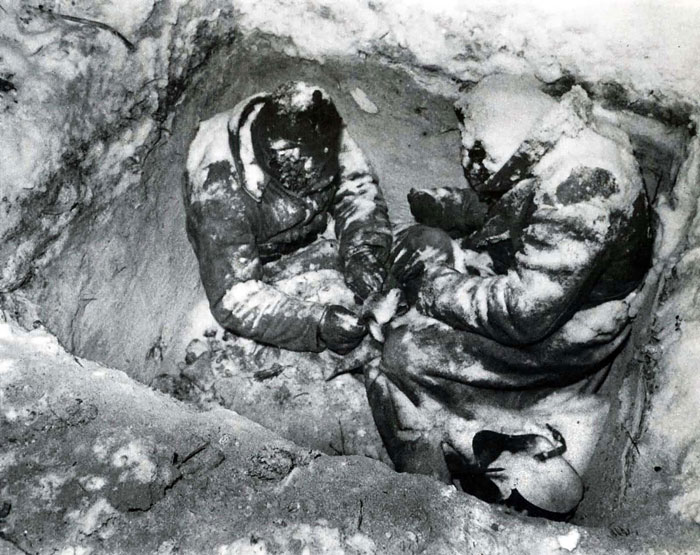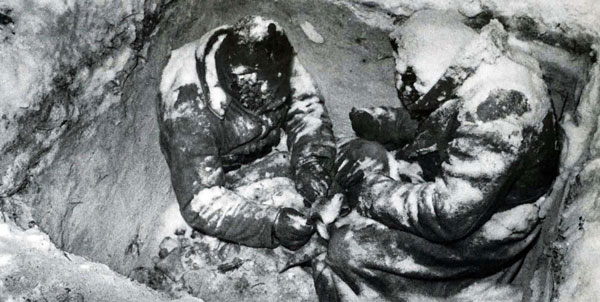Two Soviet infantrymen frozen to death in their foxhole, Winter War, Finland (1940)

In 1939 and 1940, the Soviet Union and Finland were at war. The smaller Finnish army proved tenacious. The Soviets had to bring troops from afar, including from regions that had no experience of hard winters. The Soviet army paid a heavy price for this lack of experience, as the incident known as the ‘Sausage War’.
With Finnish patrols and snipers destroying the support lines, the lack of food and supplies was huge. The Soviet troops also lack winter warfare training and gear. The saddest thing is that just by covering their fox hole with some branches with the snow on top, the temperature in the foxhole would have risen to about -3 Celsius.
With their heavy coats, the soldiers might even have felt necessity to strip some layers. That’s what happens when military leaders send untrained troops to the battlefront. But the Soviet leaders apparently didn’t care too much for their soldiers training or life.
Freezing to death is one of the most non-violent ways to die. After the shivering stops and you slip into hypothermia, it’s pretty much a warm and fuzzy sensation until you slowly doze off as your vital organs slowly begin to shut down.
If a person stays in cold, the body gives up and releases the blood back to the body, giving a brief warm feeling before dying. Some even reach a point where their body core thinks it’s too hot that they stripped their clothes off because they thought they were overheating. It’s called paradoxical undressing. This is the reason why some victims of hypothermia are found naked.
Another explanation is a cold-induced malfunction of the hypothalamus. This is the part of the brain that regulates body temperature. Another explanation is the muscles contracting peripheral blood vessels become exhausted and relax, leading to a sudden blood surge to the extremities, fooling the victim into feeling overheated.
Here are some interesting passage about the lack of food in the front during Winter War.
During the “Sausage War”) where attacking Russians behind Finnish lines came upon a Finnish field kitchen. The starving Russians ended up halting to eat anything they could find.
Also by December 5th the Soviet 155th Division was making strides towards Ilomantsi. On December 7th, Pajari arrived on the field and took command of the soldiers, and the Finns under his command were renamed Task Force Pajari. By the 9th the front was stable but still there was a massive threat of a Soviet breakthrough. Still Talvela decided that what was called for was a Finnish attack as he felt this would assist in raising Finnish morale and would also take the Soviets by surprise.
The attack was to begin on the 10th, but before this could take place, the Soviets made attacks on their own trying to flank the Finnish positions. These attacks were halted and the Finnish counterattack was reset for the 12th. It was in these Soviet attacks that the so-called “Sausage War” took place, which is one of the more interesting notes of the entire Winter War.
The Soviets had been able to sneak behind the Finnish lines and went undetected by the Finnish troops. The Soviets were about three miles to the northwest of Tolvajärvi and were ready to take the Finnish supply road. This road was lightly defended as most of the troops in the area were supply, cooks, and like soldiers.
The Soviets took the Finns by surprise and advanced quickly; however, the Soviets were stopped when they found the Finnish cooking tents full of just made sausages. The Red Army soldiers were starving and had not had hot food for many days, so the fresh cooked Finnish sausage was too large a temptation to resist.
The Soviet attack, which might have won the battle, was stopped in its tracks by the lure of hot food. The Finns were able to regroup and hunted these Soviet troops down along with most of the members of the Red Army breakthrough and killed them in the wooded areas around the roads.
– Fire and Ice, The Battles.

